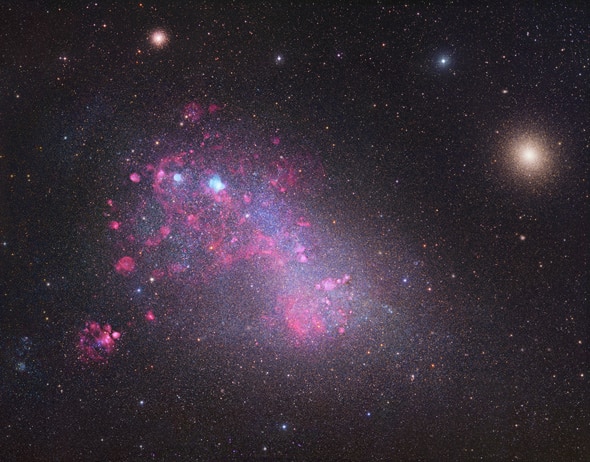Create a free profile to get unlimited access to exclusive videos, sweepstakes, and more!
Having a Gassy Neighbor Is Beautiful

Our Milky Way galaxy is a bruiser. It’s 100,000 light years across — a quintillion kilometers, or a million million million km if you prefer — and filled with stars, gas, and dust.
It also has several companion galaxies, smaller satellites orbiting it like the Moon orbits the Earth. These companions are far smaller than the Milky Way, but still vast to human experience. Two of them are visible to the naked eye, if you happen to live in the southern hemisphere (or the extreme southern northern hemisphere): the Large and Small Magellanic Clouds. Both are what we call dwarf irregular galaxies. The Large one (usually just called the LMC) appears to be struggling to make some sort of overall shape for itself, and is sometimes called a barred spiral, though that’s a little bit of a stretch in my opinion.
The Small one (or SMC) is a true irregular, a shapeless blob of stars and gas and dust roughly 7,000 light years across. And did I say gas? It’s thick with the stuff; huge clouds of hydrogen, helium, and assorted other elements and molecules in blobby patches throughout.
The image above shows that very well (and I shrank it down a lot to fit the blog, so seriously, check out the super high-res version for am eyeball-popping experience) It’s a combination of data taken by the Digitized Sky Survey and observations by Ignacio Diaz Bobillo and Ryan Hannahoe, assembled and calibrated by Robert Gendler. It shows the galaxy in visible light, but also using a filter that lets through the light from glowing hydrogen specifically. This strongly highlights gas clouds, especially those that are in the process of collapsing and forming stars. All that reddish cotton-candy glow all over the image? That’s where stars are being born!*
I was stunned by the sheer number of gas clouds in the SMC. My first thought was, “Just how many stars are being born there now?”
Astronomers call this the star formation rate, and it’s usually cited in terms of solar masses per year. So if one star with the mass of the Sun is born every year, the star formation rate is 1 solar mass per year. That’s an average; you get the same number if three stars with 1/3 the mass of the Sun each are born per year.
Poking around the web, I found that the SMC has a star formation rate of very roughly 0.04 – 0.05 solar masses per year. That was surprisingly small to me given all that gas we see in the photo! The Milky Way has a rate of more like 2-4 solar masses per year.
But wait! The S in SMC is for “Small”, after all. Just looking at its stars and gas, it has a total mass of nearly a billion times the Sun. The Milky Way has a stellar+gas mass of about 50 billion solar masses, far more massive than the SMC, roughly 50 times more (if you include invisible dark matter which surrounds both galaxies, the ratio stays very roughly the same).
So all things being equal, you might expect the Milky Way to make stars at roughly 50 times the rate the SMC does. Averaging the numbers for each galaxy and dividing gives us 3 / 0.045 = 70, so the Milky Way produces stars roughly 70 times the rate at which the SMC does. Hey, that’s actually pretty close to our assumption (for astronomers, a factor of two is “pretty close”). Nice.
I’ll note that the Milky Way makes stars pretty continuously, churning them out century after century at roughly the same rate. But the SMC has had a couple of bursts of star formation in the past, probably due to interactions with the Milky Way as it orbits. The last one was less than a billion years ago when the rate may have been as a high as 0.3 solar masses per year.
If it’s littered with gas clouds now, imagine what it must have looked like 700 million years ago, during the last burst of star birth, when it was making stars ten times faster than it is now! What a sight that would’ve been!
And as a bonus: Do see all the blobby clutches of stars all over the place (like the huge one, NGC 104, on the right)? Those are globular clusters, spheroidal-shaped collections of stars, some with up to a million stars in them! I found a half dozen without too much trouble. How many do you see? Hint: Check out the annotated version of the photo where everything is labeled. That’ll keep you busy for a while.
* Well, mostly. Some may be the sites where stars died, blowing up, expelling huge amounts of gas into space that also glows the same colors. But those are far more rare and generally smaller than sites of star formations.


























